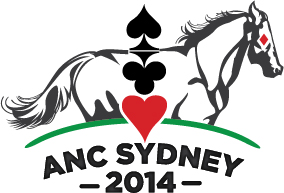Average vs Expert
Posted by Rakesh Kumar on Sunday, 20 July 2014 at 23:33
When the music stopped, many of the names at the top of list in the Open Butler were very familiar indeed. In the course of the afternoon, I was given a bit of an education about what it takes to consistently make it to the top in such events. In round 8, we were playing against Justin Howard and Gulzar Bilal. Justin is a recent top place-getter in multiple major tournaments, including winning the 2014 Bobby Richman Gold Coast Open Pairs, the 2014 VCC, the 2013 ABPF Youth Championships, and two Silver Medals at the World Youth Championships in Atlanta last year, where he also received a Sportsmanship Award. On board 27, nil vulnerable, partner opened 1NT ([12]13-15 hcp) in second seat and Justin, sitting North, bid 4♣. This space-consuming pre-empt made it difficult for me to inquire about anything, so on the assumption that even if we did have a spade fit, the spades would probably break badly, I just settled for 5♦.
On the club lead, this was self-evidently cold. I drew trumps, cashed the spade ace and led a low spade towards the king. When Justin showed out, I tabled my hand, saying "I guess I have no choice but to concede 2 spades to South." With no discernible pause for thought, Justin said, politely, "But you do have a choice -- if you run the trumps, South is squeezed in the majors." Yes, I'd have to duck one round of spades to South first, to rectify the count, but thereafter it's automatic. However, as I was only in 5♦, I didn't even think about looking for the overtrick. I might have worked it out if I had been in slam, but we never got there because of the 4♣ bid. Meanwhile Justin had figured it all out while defending ... so the one board demonstrates both the strategic bidding and the quality of hand analysis of the expert.
It probably also illustrates why I'm just average, but that's not the point.
Looking at the hand records, there were 15 pairs (of 36) who bid and made 6♦ on the squeeze, while another 15 pairs went down in slam. There was also one genuine outlier: a score of +470 to NS making 3♣ doubled! I got the story on that one. It seems East doubled the pre-emptive bid and West left it in.
East cashed a top diamond, then got some wires crossed and shifted to ♥4. West played ace, king and a third heart for East to ruff. North threw the losing spade and was somewhat bemused
when the ruff didn't materialise. He then cashed another heart, throwing a losing diamond, and took a very well marked finesse, to lose just 4 tricks!
In round 9, my education continued as our standing in the field declined, because having lost to Howard-Bilal, we found ourselves playing Simon Hinge and Bill Haughie, who are by any standards household names in Australian bridge. And the action was fast and furious. For example board 3 (South dealer, EW vul):
Simon opened the West hand 2NT and the bidding went thus:
2NT - 4♣ (slam try in clubs)
4♦ (cue agreeing clubs) - 4♠ (cue)
7♣
They were one of only 4 pairs to reach the very cold
grand slam. Two boards later they were also in the half of the field that bid a cold 6♣. Those two slams accounted for 18 IMPs of the final margin of 28 IMPs, and serve to illustrate how good hand evaluation and accurate slam bidding are such important features of the expert game.
At the end of that round, we weren't even average any more ...



